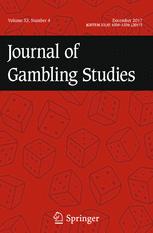 Título: Pathological gambling among adolescents: Massachusetts Gambling Screen (MAGS)
Título: Pathological gambling among adolescents: Massachusetts Gambling Screen (MAGS)
Autores: Howard J. Shaffer Ph.D., C.A.S., Richard LaBrie Ed.D., Kathleen M. Scanlan M.A., Thomas N. Cummings
Data: 1994
Abstract
This article describes the development of the Massachusetts Gambling Screen (MAGS). The purpose of the MAGS is to provide a brief clinical screening instrument that can (1) yield an index of non-pathological and pathological gambling during a 5 to 10 minute survey or interview and (2) document the first psychometric translation of the proposed DSM-IV pathological gambling criteria into a set of survey or clinical interview questions. The development data for this instrument were obtained from a survey of 856 adolescents who were students in suburban Boston high schools. The results provided evidence that weighted item scores (i.e., discriminant function coefficients) could correctly classify 96% of adolescent gamblers as pathological, in transition or non-pathological when DSM-IV criteria were employed as the conceptual referent. The results also describe the prevalence of a variety of social and emotional problems associated with adolescent gambling. Finally, the discussion examined the normalization and contemporary social context of gaming and the impact of these influences on the measurement and identification of pathological gambling.
References
-
American Psychiatric Association. (1993).DSM-IV draft criteria. Washington D.C.: American Psychiatric Press, Inc.Google Scholar
-
Clotfelter, C.T., & Cook, P.J. (1989).Selling hope: state lotteries in America. Cambridge: Harvard University Press.Google Scholar
-
Crockford, J. (1993, February 9). To bay staters, life’s a gamble: Scratch tickets push lottery to sales record.The Patriot Ledger, 1, 8.Google Scholar
-
Cronbach, L. (1951). Coefficient alpha and the internal structure of tests.Psychometrika, 16, 297–334.Google Scholar
-
DeVellis, R.F. (1991).Scale development: Theory and applications. Newbury Park, CA: SAGE Publications.Google Scholar
-
Eadington, W.R. (1992, October 27). Emerging public policy challenges from the proliferation of gaming in America, Paper Presented at the Second Annual Australian Conference on Casinos and Gambing.Google Scholar
-
Gilbert, E.S. (1968). On discrimination using qualitative variables.Journal of the American Statistical Association, 63, 1399–1412.Google Scholar
-
Hochstim, J.R. (1967). A critical comparison of three strategies of collecting data from households.Journal of the American Statistical Association, 62, 976–987.Google Scholar
-
Jacobs, D.F. (1989). Illegal and undocumented: a review of teenage gambling and the plight of children of problem gamblers in America. In Shaffer, H.J. & Stein, S.A., Gambino, B., & Cummings, T.N. (Eds.):Compulsive Gambling: Theory, Research and Practice. Lexington, Mass.: Lexington Books, 249–292.Google Scholar
-
Johnston, L.D., O’Malley, P.M., & Bachman, J.G. (1993).National survey results on drug use from monitoring the future study, 1975–1992. NIH Publication 93-3597. Washington, D.C.: U.S. Government Printing Office.Google Scholar
-
Ladouceur, R., & Mireault, C. (1988). Gambling behaviors among high school students in the Quebec area.Journal of Gambling Behavior, 4, 3–11.Google Scholar
-
Lesieur, H.R. (1989). Current research into pathological gambling and gaps in the literature. In H. Shaffer, S. Stein, B. Gambino, & T. Cummings (Eds.),Compulsive Gambling: Theory, Research, & Practice. Lexington: Lexington Books, pp. 225–248.Google Scholar
-
Lesieur, H.R., & Blume, S.B. (1987). The south oaks gambling screen (SOGS): A new instrument for the identification of pathological gamblers.American Journal of Psychiatry, 144, 1184–1188.Google Scholar
-
Lesieur, H.R., & Klein, R. (1987). Pathological gambling among high school students.Addictive Behaviors, 12, 38–47.Google Scholar
-
McAuliffe, W.E., LaBrie, R., Mulvaney, N., Shaffer, H.J., Levine, E., Wortman, S., Singer, D., Cochran, D., French, J., Gillespie, S., Goff, C., Kohlenberg, E., Lutz, G., Marel, R., Maxwell, J., McCan, I., Wilson, R., Wish, E. (1993).The national technical center’s telephone substance dependence needs assessment questionnaire and documentation(Version 3.1). Cambridge, MA: National Technical Center for Substance Abuse Needs Assessment, Harvard University.Google Scholar
-
Mechanic, D. (1968).Medical sociology: A selective view. New York: The Free Press.Google Scholar
-
Moore, D.H. (1973). Evaluation of five discrimination procedures for binary variables.Journal of the American Statistical Association, 68, 399.Google Scholar
-
Norusis, M.J. (1993).SPSS for Windows: Professional Statistics (Release 6.0). Chicago, Illinois.Google Scholar
-
Selzer, M.L., Vonokur, A., & van Rooijen, L. (1975). A self-administered short Michigan alcoholism screening test (SMAST).Journal of Studies on Alcohol, 36, 117–126.Google Scholar
-
Shaffer, H., & Zinberg, N.E. (1985). The social psychology of intoxicant use: the natural history of social settings and social control.Bulletin of the Society of Psychologists in the Addictive Behaviors, 4, 49–55.Google Scholar
-
Vaillant, G.E., & Schnurr (1988). What is a case?Archives of General Psychiatry, 45, 313–319.Google Scholar
-
Wells, K.B., Burham, M.A., Leake, B., & Robins, L.N. (1988). Agreement between face-to-face and telephone administered versions of the depression section of the NIHM diagnostic interview schedule.Journal of Psychiatric Research, 22, 207–220.Google Scholar
-
Winters, K.C., Stinchfield, R.D., & Fulkerson, J. (1993). Toward the development of an adolescent gambling problem severity scale.Journal of Gambling Studies, 9, 63–84.Google Scholar
-
Zinberg, N.E. (1984).Drug, set, and setting: the basis for controlled intoxicant use. New Haven: Yale University Press.Google Scholar
-
Zinberg, N.E., & Shaffer, H.J. (1985). The social psychology of intoxicant use: the interaction of personality and social setting. In H. Milkman and H. Shaffer (Eds.),The Addictions: Multidisciplinary Perspectives and Treatments, Lexington, MA: Lexington Books.Google Scholar
Fonte: Springer















